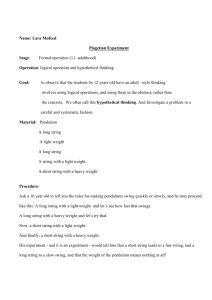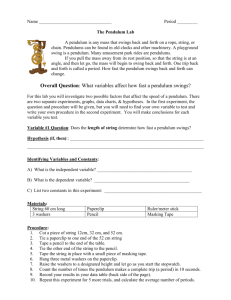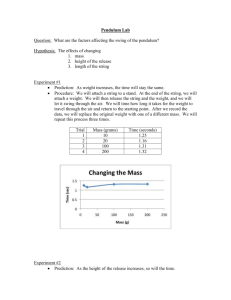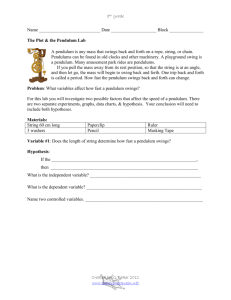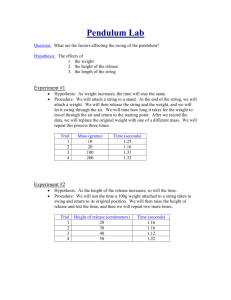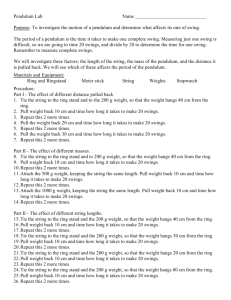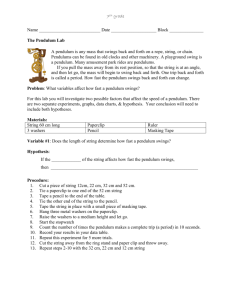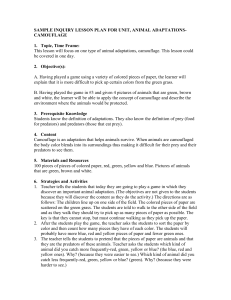good experimental design”.
advertisement
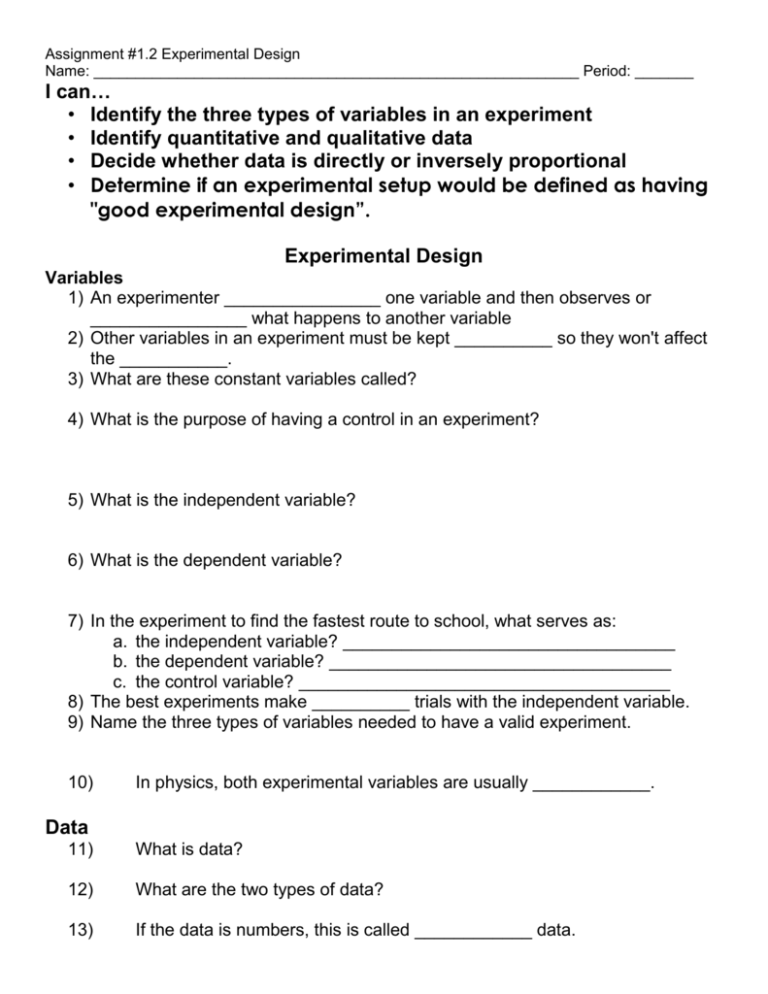
Assignment #1.2 Experimental Design Name: __________________________________________________________ Period: _______ I can… • Identify the three types of variables in an experiment • Identify quantitative and qualitative data • Decide whether data is directly or inversely proportional • Determine if an experimental setup would be defined as having "good experimental design”. Experimental Design Variables 1) An experimenter ________________ one variable and then observes or ________________ what happens to another variable 2) Other variables in an experiment must be kept __________ so they won't affect the ___________. 3) What are these constant variables called? 4) What is the purpose of having a control in an experiment? 5) What is the independent variable? 6) What is the dependent variable? 7) In the experiment to find the fastest route to school, what serves as: a. the independent variable? __________________________________ b. the dependent variable? ___________________________________ c. the control variable? ______________________________________ 8) The best experiments make __________ trials with the independent variable. 9) Name the three types of variables needed to have a valid experiment. 10) In physics, both experimental variables are usually ____________. Data 11) What is data? 12) What are the two types of data? 13) If the data is numbers, this is called ____________ data. Assignment #1.2 Experimental Design 14) 15) To be useful, collected data must be _____________. Name 3 ways of organizing data. 16) When both variables increase, they are ____________ proportional. 17) When one variable increases and the other decreases, they are ______________ proportional. Practice Problems Betty’s science expo experiment involves getting 8 bottles of Diet Coke and putting 1 or 2 or 3,… or up to 8 mentos in each bottle and collecting the foam that forms. After the reaction is over, she pours the foam into a measuring cup and writes down the volume. No. of Mentos 1 2 3 4 5 6 7 8 Foam vol (ml) 1) What is the independent variable in this experiment? 2) What is the dependent variable in this experiment? 3) List AT LEAST 3 control variables the student should keep constant during all 8 trials. 4) Their hypothesis was that more mentos lead to more foam. Was their hypothesis directly or inversely proportional? 5) Fill in the data table with data that would contradict their hypothesis. Davey’s science expo experiment involves putting marshmallows in the microwave for different amounts of time (starting at 10 seconds, up to 80 seconds) and measuring their maximum diameter on a plastic mat with centimeters marked on it that the marshmallows are sitting on. 6) What is the independent variable in this experiment? 7) What is the dependent variable in this experiment? Assignment #1.2 Experimental Design 8) List AT LEAST 3 control variables for this experiment. 9) Write a valid hypothesis for this experiment that indicates a directly proportional relationship. 1) Label each example of data as quantitative or qualitative a. 4.5 grams _________ d. Floats ____________ b. Blue _____________ e. Baseball __________ c. 23 cm ____________ f. 34 seconds ________ 2) Label each variable as quantitative or qualitative a. Height ______________ d. Does it fall? __________ b. Gender _____________ e. Mass _______________ c. Type of ball __________ f. Amount of water ______ Simple Pendulum—a mass hung on a string that swings back and forth. Brainstorm 5 possible independent variables and 5 possible dependent variables for this experiment. 10) Independent Variables Dependent Variables Assignment #1.2 Experimental Design (Mangers: Allow 2 minutes for group members to read the following) Read the following section on the requirements for "good experimental design”. Designing a “good experiment” involves three major components. 1. Contains enough detailed STEP by STEP directions that it could be repeated by someone else WITHOUT them needing to talk to the experimenter. This is just like a recipe book for making cookies. The recipe contains the exact amounts of each item that will be involved as well as the step by step directions for when to add each item. 2. It ONLY contains ONE independent variable and ONE dependent variable. This allows the experimenter to draw conclusions at the end of the experiment based on the data. If more than one independent variable is changed then the experimenter cannot identify whether the change is caused by one or the other variable or a combination of both. 3. All other possible variables must be CONTROL variables. This allows the experimenter to ensure that the changes that occur during the experiment are caused by the independent variable and not some other variable that the experimenter “FORGOT” to control. The general rule for experimental design in terms of variables is One independent variable One dependent variable Infinity minus 2 Control Variables. In other words every other possible variable MUST be controlled besides the independent and dependent variables. As a group discuss the following experimental designs written by students and answer the questions associated with each design based on an experiment with a simple pendulum swinging back and forth. Assignment #1.2 Experimental Design Lenny’s Procedure: 1. Get supplies. 2. Change mass. 3. Measure time to swing. 11) Look at the procedure above written by a physical science student for his science expo project. Determine the independent, dependent, and control variables he chose for his experiment. Independent: ______________________ Dependent: _______________________ Controls: _________________________________________________________ 12) Are the control variables controlled? Explain.________________________ ________________________________________________________________ 13) Is there enough detail to replicate (repeat) the experiment? Explain. ________________________________________________________________ ________________________________________________________________ 14) Is this a good procedure? Why or why not? ________________________ Sasha’s Procedure: Supplies: nylon string, 20 – USS flat washers 5/16, timer, protractor 1. Tie a loop in a length of string that is 1 m long. 2. Secure string to a stable object so it has room to swing back and forth freely. 3. Open paper clip and hook to string loop. 4. Place two washers on the paperclip to serve as the bob (mass on the end of the string). 5. Pull the pendulum back to an angle of 20˚ from vertical and release. 6. Start timer when the pendulum swings back to its starting point. 7. Count 10 swings back and forth (out and back counts as one). 8. Stop timer at the end of the 10th swing. 9. Repeat the steps above adding two washers to the paperclip each time. 15) Look at the procedure above written by a physical science student for her science expo project. Determine the independent, dependent, and control variables she chose for her experiment. Independent: ___________________ Dependent: _______________________ Controls: ________________________________________________________ 16) Are the control variables controlled? Explain. __________________________ ________________________________________________________________ 17) Is there enough detail to replicate (repeat) the experiment? Explain. ________________________________________________________________ ________________________________________________________________ 18) Is this a good procedure? Why or why not? ___________________________ Assignment #1.2 Experimental Design Tigo’s Procedure: Supplies: nylon string, 500-g brass mass, timer, protractor 1. Tie a loop in a length of string that is 70 cm long. 2. Secure string to a stable object so it has room to swing back and forth freely. 3. Place 500-g mass on the end of the string. 4. Pull the pendulum back to an angle of 5˚ from vertical and release. 5. Start timer when the pendulum swings back to its starting point. 6. Count 10 swings back and forth (out and back counts as one). 7. Stop timer at the end of the 10th swing. 8. Increase string length by 10 cm. a. Repeat steps above increasing angle of release by 5˚ each time. 19) Look at the procedure above written by a physical science student for his science expo project. Determine the independent, dependent, and control variables he chose for his experiment. Independent: ____________________ Dependent: _______________________ Controls: _________________________________________________________ 20) Are the control variables controlled? Explain. __________________________ ________________________________________________________________ 21) Is there enough detail to replicate (repeat) the experiment? Explain. ________________________________________________________________ ________________________________________________________________ 22) Is this a good procedure? Why or why not? ___________________________ NOW FILL THE FACTS YOU LEARNED INTO YOUR ESSENTIAL FACTS BOOKLET FOR UNIT 1!
